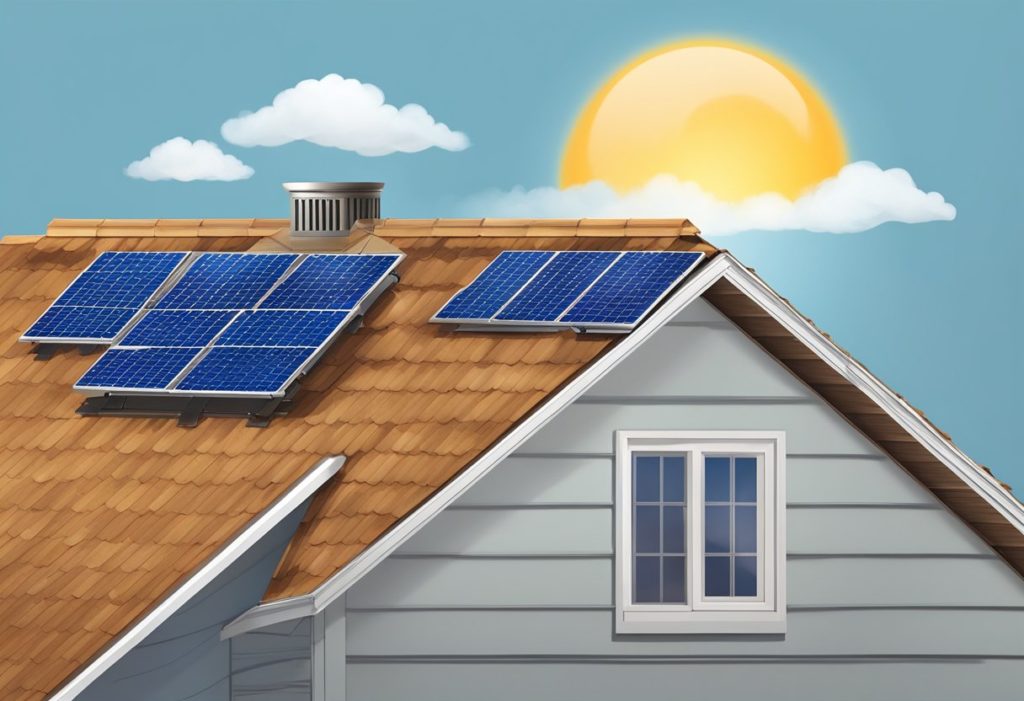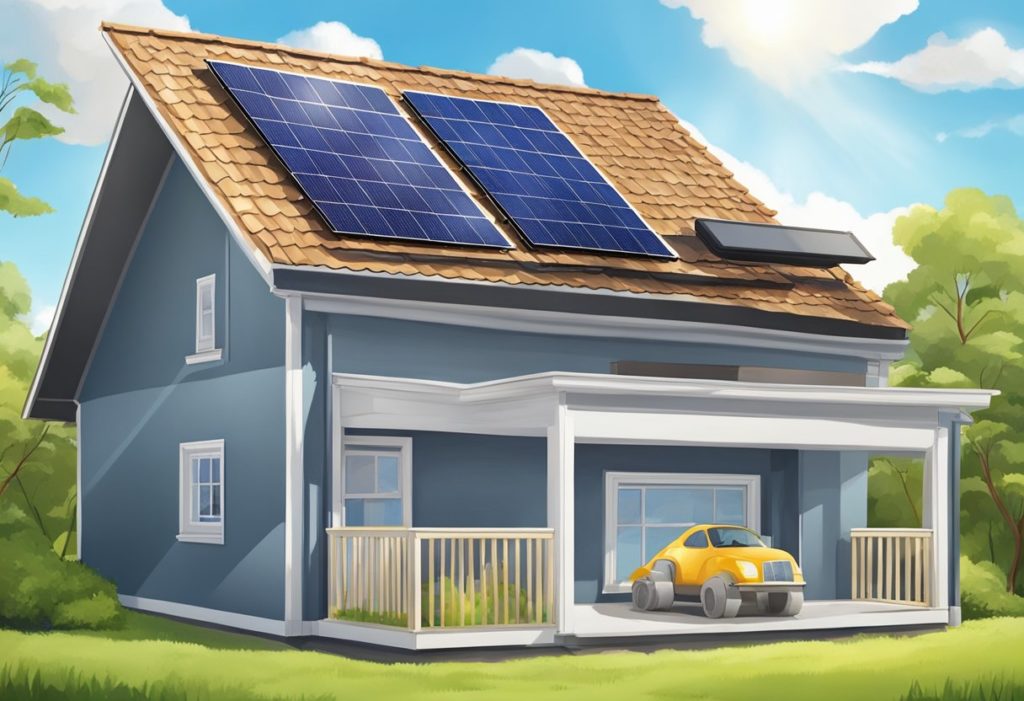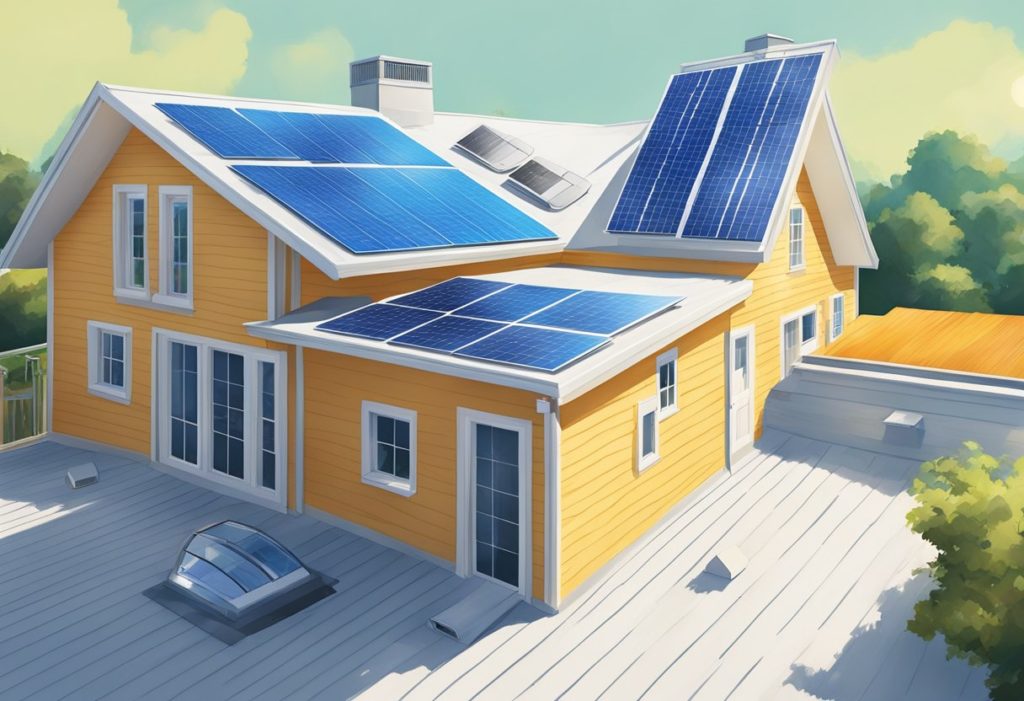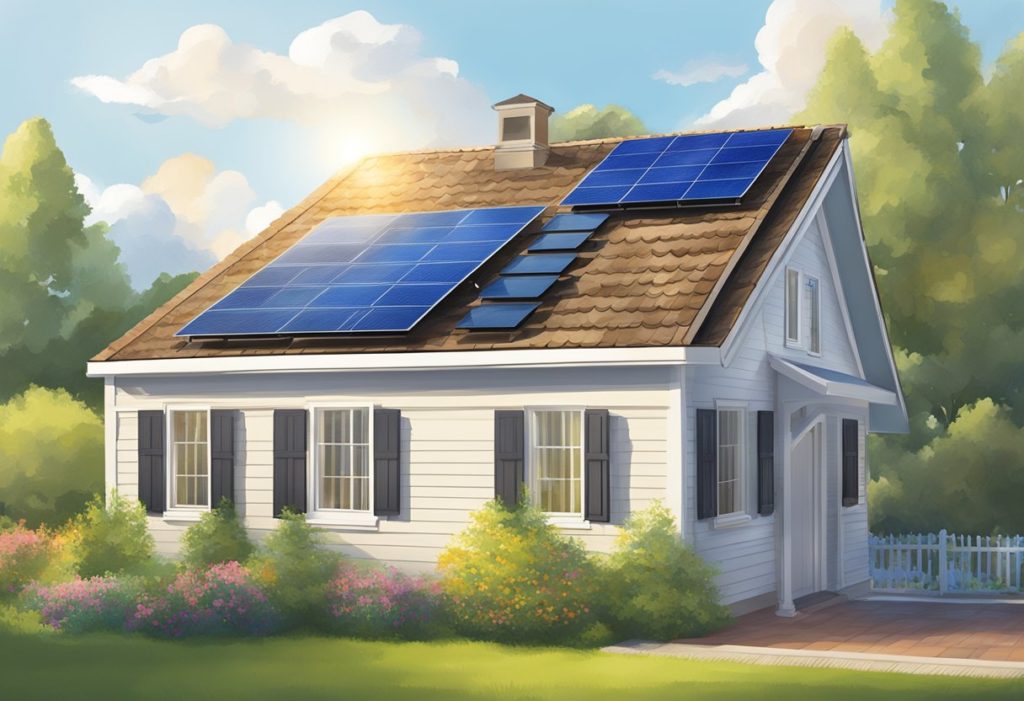
Solar powered attic fans are a great way to reduce cooling costs and improve indoor air quality. These fans work by harnessing the power of the sun to ventilate your attic, which can help to keep your home cooler and reduce the load on your air conditioning system. This article will explore the benefits of solar powered attic fans, how they work, and provide an installation guide, cost analysis, and maintenance tips to help you get the most out of your solar powered attic fan.
One of the biggest benefits of solar powered attic fans is that they can help to reduce your cooling costs. By ventilating your attic, these fans can help to remove heat buildup, which can make your home more comfortable and reduce the load on your air conditioning system. Additionally, solar powered attic fans can help to improve indoor air quality by reducing moisture buildup and preventing mold and mildew growth.
If you’re interested in installing a solar powered attic fan, it’s important to understand how they work. These fans are typically installed on the roof of your home and are powered by solar panels. As the sun shines on the solar panels, they generate electricity which powers the fan. The fan then pulls hot air out of your attic and replaces it with cooler, fresh air from outside.
Key Takeaways
- Solar powered attic fans can help reduce cooling costs and improve indoor air quality.
- These fans work by harnessing the power of the sun to ventilate your attic.
- Solar powered attic fans are typically installed on the roof of your home and are powered by solar panels.
Benefits of Solar Powered Attic Fans
Solar powered attic fans can provide a range of benefits for homeowners looking to improve their home’s energy efficiency. Here are some of the key benefits of installing a solar attic fan in your home:
Extend Roof Lifespan
One of the most significant benefits of a solar powered attic fan is that it can help extend the lifespan of your roof. When your attic gets too hot, it can cause the shingles on your roof to deteriorate more quickly, leading to leaks and other damage. By keeping your attic cool and well-ventilated, a solar attic fan can help prevent this type of damage and extend the lifespan of your roof.
Enhance Home Comfort
Another benefit of a solar powered attic fan is that it can enhance the overall comfort of your home. When your attic is too hot, it can make the rest of your home feel uncomfortably warm as well. By keeping your attic cool and well-ventilated, a solar attic fan can help reduce the temperature in your home and make it more comfortable to live in.
Energy Savings and Efficiency
Finally, a solar powered attic fan can help you save money on your energy bills and improve your home’s energy efficiency. By reducing the temperature in your attic, a solar attic fan can help reduce the workload on your air conditioning system, which can help lower your energy bills. Additionally, because solar attic fans are powered by the sun, they don’t require any electricity to operate, which can further reduce your energy costs and help you save money over time.
Overall, a solar powered attic fan can be a smart investment for any homeowner looking to improve their home’s energy efficiency and comfort. By extending the lifespan of your roof, enhancing home comfort, and reducing energy costs, a solar attic fan can provide a range of benefits that make it well worth considering.
How Solar Powered Attic Fans Work

Solar powered attic fans are an excellent way to reduce cooling costs and improve the ventilation of your home. They work by using a solar panel to convert sunlight into electricity, which powers a fan that draws hot air out of the attic. Here is a breakdown of the technology and mechanics behind solar powered attic fans.
Solar Panel Technology
The solar panel on a solar powered attic fan is made up of photovoltaic cells that convert sunlight into direct current (DC) electricity. The panel is mounted on the fan itself or on the roof, and is wired to the fan motor. The panel is designed to capture as much sunlight as possible, even on cloudy days, and convert it into electricity to power the fan.
Fan Operation and Airflow Dynamics
The fan in a solar powered attic fan is designed to move hot air out of the attic. As the fan spins, it draws air through the vents in the attic and exhausts it out of the roof. This creates a negative pressure in the attic, which draws in cooler air from the outside. The result is a constant flow of air through the attic, which helps to regulate the temperature and humidity levels.
The airflow dynamics of a solar powered attic fan are important to understand. The size and location of the fan, as well as the number and placement of vents in the attic, all play a role in determining how much air is moved through the attic. A properly designed and installed system can significantly reduce cooling costs and improve the overall comfort of the home.
In summary, solar powered attic fans use photovoltaic cells to convert sunlight into electricity, which powers a fan that draws hot air out of the attic. The fan creates a negative pressure in the attic, which draws in cooler air from the outside. The result is a constant flow of air through the attic, which helps to regulate the temperature and humidity levels. Properly designed and installed systems can significantly reduce cooling costs and improve the overall comfort of the home.
Installation Guide

Selecting the Right Model
Before buying a solar-powered attic fan, it is essential to determine the size of your attic and the amount of ventilation required. A general rule of thumb is to have one square foot of ventilation for every 150 square feet of attic space. You should also consider the roof pitch, as steeper roofs require fans with higher CFM ratings.
When selecting a model, look for fans with durable materials that can withstand extreme weather conditions. Also, consider the warranty and the manufacturer’s reputation for producing reliable products.
Step-by-Step Installation Process
- Locate the best spot for the fan. It should be installed on the roof’s sunny side and away from any obstructions.
- Measure and mark the location of the fan on the roof.
- Cut a hole in the roof using a reciprocating saw or a jigsaw.
- Remove shingles from around the hole and apply a continuous bead of tri-polymer roofing cement.
- Set the roof vent over the hole and screw the fan’s flashing to the roof.
- Apply more caulking around the flashing to ensure a waterproof seal.
- Connect the fan’s wires to the solar panel and mount the panel on the roof or nearby.
- Turn on the fan and ensure it is operating correctly.
Safety Tips and Best Practices
When installing a solar-powered attic fan, it is essential to follow safety guidelines to prevent accidents. Always wear protective gear such as gloves, safety glasses, and non-skid shoes. Use a sturdy ladder that can support your weight and the weight of the equipment.
Before cutting into the roof, ensure there are no electrical wires, plumbing, or other obstructions in the area. If you are not confident in your ability to install the fan, consider hiring a professional to do the job.
In conclusion, installing a solar-powered attic fan can reduce cooling costs and improve indoor air quality. By following the above steps and safety guidelines, you can enjoy the benefits of a well-ventilated attic without compromising your safety.
Cost Analysis
Initial Investment
Solar-powered attic fans have a higher upfront cost compared to traditional electric-powered attic fans. The cost of a solar-powered attic fan can range from $200 to $500, depending on the brand and model. In addition, the cost of installation can range from $100 to $300, depending on the complexity of the installation. However, the initial investment can pay off in the long run.
Long-Term Savings
The long-term savings of a solar-powered attic fan can be significant. Solar-powered attic fans can reduce cooling costs by up to 30%. The fan operates during the day when the sun is shining, which is when the attic is the hottest. By removing hot air from the attic, the fan reduces the workload of the air conditioning system, which can lead to lower energy bills.
In addition, solar-powered attic fans have a longer lifespan than traditional electric-powered attic fans. The fan’s motor is not subject to wear and tear from electricity, which can extend the fan’s lifespan by up to 25 years. This can lead to additional savings over time.
Incentives and Rebates
There are several incentives and rebates available for the installation of a solar-powered attic fan. The federal government offers a tax credit of up to 26% of the total cost of the fan and installation. In addition, some states and local governments offer additional incentives and rebates. Homeowners should check with their state and local government to see what incentives and rebates are available.
In conclusion, while the initial investment of a solar-powered attic fan may be higher than a traditional electric-powered attic fan, the long-term savings and incentives can make it a worthwhile investment.
Maintenance and Care

Solar-powered attic fans require minimal maintenance and care. However, it is essential to keep them clean and perform routine inspections to ensure they are functioning correctly.
Routine Inspection Schedule
It is recommended to inspect your solar-powered attic fan at least once a year. The ideal time to perform an inspection is during the spring when the weather is mild. During the inspection, check the fan’s housing, blades, and motor for any signs of wear and tear. If you notice any damage, it is best to replace the parts immediately.
Cleaning and Upkeep
To keep your solar-powered attic fan in good condition, it is essential to clean it regularly. The fan’s blades can accumulate dust and debris, which can impact its performance. To clean the blades, use a soft cloth or brush to remove any dirt or debris. You can also use a garden hose to rinse off any stubborn debris.
Additionally, ensure that the solar panel is free of any dirt or debris, as this can impact its efficiency. To clean the solar panel, use a soft cloth or sponge and a mild detergent solution. Avoid using abrasive cleaners or solvents, as these can damage the panel’s surface.
Troubleshooting Common Issues
If you notice that your solar-powered attic fan is not functioning correctly, there are a few common issues you can troubleshoot. First, check the wiring connections to ensure they are secure and not damaged. If the wiring is damaged, it may need to be replaced.
You should also check the fan’s motor to ensure it is functioning correctly. If the motor is not working correctly, it may need to be replaced. Finally, check the solar panel to ensure it is receiving enough sunlight. If the panel is not receiving enough sunlight, you may need to relocate it to a sunnier location.
By following these maintenance and care tips, you can ensure that your solar-powered attic fan functions correctly and efficiently.
Product Comparisons

Top Solar Attic Fan Models
When it comes to solar-powered attic fans, there are several models available in the market. Here are some of the top solar attic fan models that are worth considering:
| Model | Power | Airflow | Price |
|---|---|---|---|
| Remington Solar Attic Fan | 20-40 watts | 1,280-2,340 CFM | $300-$400 |
| Broan-NuTone Low Profile Solar Attic Fan | 28 watts | 537 CFM | $350 |
| Natural Light Solar Attic Fan | 10-36 watts | 850-1628 CFM | $400-$600 |
The Remington Solar Attic Fan is a top-rated product that is known for its efficient performance and durability. It is available in different power levels ranging from 20 to 40 watts, with an airflow of 1,280 to 2,340 CFM. The product comes with a lifetime warranty, making it a reliable option for homeowners.
Another popular option is the Broan-NuTone Low Profile Solar Attic Fan. It is a compact and low-profile fan that features a 537 CFM rating, which is higher than most solar attic fans. It is also easy to install and comes with a 6-year warranty.
The Natural Light Solar Attic Fan is a high-performance product that is designed to provide excellent ventilation in the attic. It is available in different power levels ranging from 10 to 36 watts, with an airflow of 850 to 1628 CFM. The product comes with a 25-year warranty, making it a long-lasting and reliable option.
Feature and Performance Evaluation
When comparing solar attic fan models, it is important to consider their features and performance. Here are some of the key factors to look for:
- Power: The power of the fan determines its performance and efficiency. A higher power rating means better ventilation and cooling.
- Airflow: The airflow of the fan determines how much air it can move in a given time. A higher airflow rating means better ventilation and cooling.
- Warranty: A good warranty ensures that the product is reliable and long-lasting. Look for products with at least a 6-year warranty.
- Price: The price of the product is an important factor to consider. Look for products that offer good value for money.
Overall, solar attic fans are an excellent option for homeowners who want to reduce their cooling costs and improve ventilation in their attics. By comparing different models and considering their features and performance, homeowners can choose the best solar attic fan for their needs and budget.
Environmental Impact

Solar-powered attic fans have a significant impact on the environment. They help reduce the carbon footprint of homes and buildings by reducing the amount of energy needed to cool them. This section will discuss the environmental impact of solar-powered attic fans.
Reduction in Carbon Footprint
One of the main advantages of solar-powered attic fans is that they reduce the amount of energy needed to cool homes and buildings. By reducing the amount of energy used, they also reduce the amount of greenhouse gases emitted into the atmosphere. This reduction in greenhouse gas emissions helps to mitigate climate change and its negative impacts.
Sustainable Energy Use
Solar-powered attic fans use sustainable energy from the sun to power their operation. This means that they do not rely on fossil fuels or other non-renewable energy sources. By using sustainable energy, solar-powered attic fans contribute to a more sustainable future for our planet.
In conclusion, solar-powered attic fans have a positive environmental impact by reducing the carbon footprint of homes and buildings and promoting sustainable energy use. They are an effective and efficient way to reduce cooling costs while also contributing to a greener future.
*Also check out our solar powered lights outdoors review, if you need to light out your yard on the cheap.
Frequently Asked Questions
How do solar powered attic fans contribute to reducing cooling costs?
Solar powered attic fans work by removing hot air from the attic and replacing it with cooler air from outside. This reduces the temperature in the attic, which in turn reduces the amount of heat that is transferred to the living space below. By reducing the heat load on the air conditioning system, solar powered attic fans can help to reduce cooling costs.
What factors should be considered when choosing the best solar attic fan?
When choosing a solar attic fan, it is important to consider factors such as the size of the attic, the amount of ventilation required, and the power output of the fan. Other important factors include the quality of the materials used in the construction of the fan, the warranty offered by the manufacturer, and the level of noise produced by the fan.
Can the installation of a QuietCool solar attic fan lead to significant energy savings?
Yes, the installation of a QuietCool solar attic fan can lead to significant energy savings. According to the manufacturer, QuietCool solar attic fans can reduce attic temperatures by up to 50 degrees, which can result in a reduction in cooling costs of up to 30%. In addition, QuietCool solar attic fans are designed to be energy efficient, with a low power consumption of just 15 watts.
What is the average cost of a solar attic fan, including installation?
The cost of a solar attic fan can vary depending on factors such as the size of the fan, the quality of the materials used, and the complexity of the installation. On average, the cost of a solar attic fan ranges from $300 to $700, including installation.
*If you wish to find out more about an installation of a complete solar power system near you, read our guide here.
What are the potential disadvantages or drawbacks of installing a solar attic fan?
One potential drawback of installing a solar attic fan is that it may not be effective in all climates. In areas with high humidity or low levels of sunlight, solar attic fans may not be able to provide sufficient ventilation. In addition, solar attic fans may be more expensive than traditional electric attic fans, and may require more maintenance.
How does the effectiveness of solar attic fans compare to traditional electric attic fans?
Solar attic fans are generally considered to be more effective than traditional electric attic fans, as they do not require electricity to operate and can provide ventilation even during power outages. In addition, solar attic fans are typically quieter and more energy efficient than electric attic fans. However, the effectiveness of a solar attic fan will depend on factors such as the size of the attic and the amount of ventilation required.
Conclusion
Solar powered attic fans and ventilation systems are a smart investment for homeowners looking to reduce cooling costs. By harnessing the power of the sun, these fans can help to lower the temperature in your attic and prevent heat from seeping into your home.
Based on the search results, solar attic fans can reduce attic temperatures by up to 50°F, resulting in potential savings of up to 10-30% on cooling costs. They are also easy to install and require no electricity to operate, making them a low-maintenance option for homeowners.
When choosing a solar powered attic fan, it is important to consider factors such as the size of your attic and the amount of ventilation needed. It is also important to choose a reputable brand and to ensure that the fan is properly installed to maximize its effectiveness.
Overall, solar powered attic fans are a cost-effective and eco-friendly way to reduce cooling costs and improve the comfort of your home. If you’re looking to save money on your energy bills and reduce your carbon footprint, consider installing a solar powered attic fan today.